Abstract
Within the domain of tribology, the science and technology for understanding and controlling friction, lubrication, and wear of relatively moving interacting surfaces, countless experiments are carried out and their results are published worldwide. Due to the variety of test procedures and a lack of consistency in the terminology as well as the practice of publishing results in the natural language, accessing and reusing tribological knowledge is time-consuming and experiments are hardly comparable. However, for the selection of potential tribological pairings according to given requirements and to enable comparative evaluations of the behavior of different tribological systems or testing conditions, a shared understanding is essential. Therefore, we present a novel ontology tribAIn (derived from the ancient Greek word “tribein” (= rubbing) and the acronym “AI” (= artificial intelligence)), designed to provide a formal and explicit specification of knowledge in the domain of tribology to enable semantic annotation and the search of experimental setups and results. For generalization, tribAIn is linked to the intermediate-level ontology EXPO (ontology of scientific experiments), supplemented with subject-specific concepts meeting the needs of the domain of tribology. The formalization of tribAIn is expressed in the W3C standard OWL DL. Demonstrating the ability of tribAIn covering tribological experience from experiments, it is applied to a use case with heterogeneous data sources containing natural language texts and tabular data.
1. Introduction
Transport, power generation, and production are vital industrial activities in a highly developed modern society. They involve the movement of people and materials of all kinds by different machines and mechanical/electrical systems, which have numerous relatively moving parts and interacting surfaces. Reliable, durable, and smooth operation of such machines is highly dependent on how well friction and wear are controlled. Following the so-called Jost report [1] on the social and economic relevance in 1966, the science and technology for understanding and controlling friction, lubrication, and wear of relatively moving interacting surfaces has been named as “tribology”. According to more recent studies from Holmberg and Erdemir [2], approximately 23% of today’s world energy consumption originates from tribological issues, whereby about 20% is consumed to overcome friction and roughly 3% is needed to replace or remanufacture parts due to wear. In the context of increasing demands for higher power density and reliability in combination with diminishing resources, rising environmental awareness, and stricter legal requirements, energy losses could be tremendously reduced by taking advantage of new surface, material, and lubrication technologies in numerous applications [3,4,5,6,7,8]. To investigate the potential and optimize the performance of novel technologies and to gain an understanding for the role of various parameters on the friction and wear behavior, countless tribological experiments are constantly being carried out worldwide and their results published. In the past, tribological knowledge was most commonly transferred by online manuals, checklists, figures, and tables, making access time-consuming. Therefore, only literature databases and online databases effectively provided fast access to tribological experiences [9]. The interpretation of experimental results from the literature in the natural language is also time-consuming within the design of tribological experiments for the evaluation of new materials, lubricants, or surface technologies for their potential to tailor friction and wear. Moreover, searching for relevant information is seen as a non-value-added activity [10] and is even problematic as interpretation of the natural language often leads to misunderstandings. Inconsistent terms with different definitions and units as well as missing information has also hampered the comparison of data. Moreover, a lack of standardization and formalization is even obstructive for the application of machine learning support within search and retrieval operations as well as the automatization of analysis. The use of computational and artificial intelligent techniques in tribology to control experiments, collect and analyze data, or to predict the behavior by advanced tribo-simulations on different scales [11] or meta-levels is not new [11,12]. However, the generation of appropriate experimental knowledge bases, such as those for mechanical, chemical, or physical material properties (e.g., among others EMMO (https://emmc.info/emmo-info/), CAMPUS (https://www.campusplastics.com/), or Stahlschlüssel(http://www.stahlschluessel.de/en/)), are surprisingly underexplored. The fact that a generally valid philosophy for dealing with results and data has not yet been established might also be related to the use of many cross-domain concepts, leading to a quantity of heterogeneous data on multiple scales, with varying measurement uncertainties and in different formats across manifold resources. In addition, respective measurements are normally carried out in the context of extensive design of experiments [13]. Moreover, frictional and wear parameters as irreversible loss variables always describe the time-dependent behavior of a system (Figure 1) and therefore do not represent only hard data.
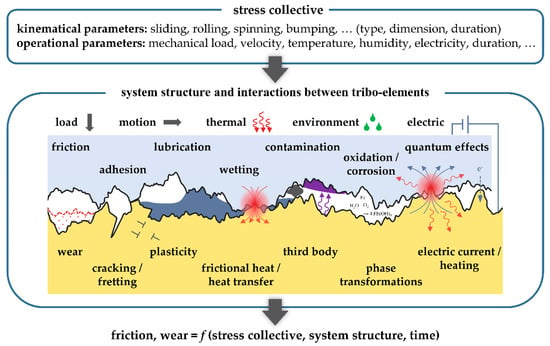
Figure 1.
Parameter groups of tribological experiments and interaction in tribo-contacts accordingly. Redrawn from [11,13].
Tribometry, i.e., tribological measuring and testing technology, is used to determine friction and wear characteristics of tribological systems and covers all scales of tribology. The significance of various quantitative measured variables, for example, a friction coefficient or a wear coefficient averaged over time, usually depends on the underlying mechanisms, the measuring method, and the respective objective. Since various superimposed influencing factors have to be taken into account, test methods need be designed carefully and with regard to statistical issues. Considering the function and structure of tribological systems, testing technology can be divided into six categories (see Figure 2) according to the simplification of the system structure, the stress collective, or the ambient conditions. While original and complete systems are tested in machinery field or bench tests under real operating and environmental conditions, in system bench tests, this is done under laboratory conditions with only application-oriented conditions. In component or specimen tests, this is further reduced to the testing and examination of original units and parts or component-like specimens. Finally, model tests are used for basic research on friction and wear processes using special or standardized specimens under selected loads. Frequently, the advantages of the individual test categories can be combined by a suitable test chain.
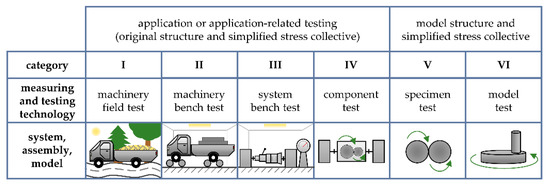
Figure 2.
Categories of tribological testing. Redrawn from [13].
For the aforementioned reasons, the reuse of existing tribological knowledge highly depends on the access to it and the quality of documentation. Producing experimental knowledge is usually divided in the three steps of experimental design, experimental procedure, and experimental results (Figure 3) and involves a lot of background knowledge from domain experts. First, the domain expert has to design an experimental setup, including the fabrication of test samples suited to the assessed tribosystem, the definition of the target variable, and the kinematical and operational parameters. The tribosystem is the experimental model used for studying time-dependent friction and wear parameters and consists of at least two relatively moving objects (e.g., ball/disc, bearing components, etc.) in contact, an interfacial medium (e.g., lubricants), and the environmental medium (e.g., air). Since the evolution of friction and wear parameters depends on the different influences from the stress collective and the system structure (see Figure 1), investigations aim to determine the influence of an isolated variable on the behavior, which is signed as the target variable of the investigation. Depending on the goal of the investigation, these can be a variation in physical quantities (e.g., humidity of the environmental medium) as well as a variation of materials or interfacial medium. The configuration of the experimental setup is defined by the kinematical (e.g., sliding mode and distance) and operational parameters (e.g., force, temperature).
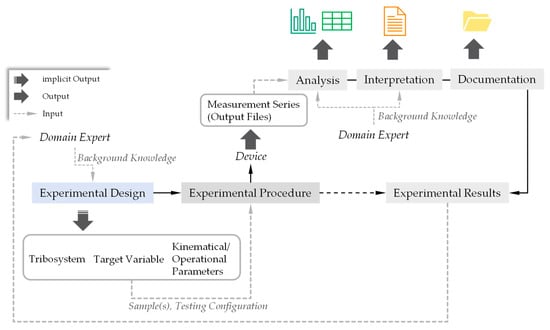
Figure 3.
Process of producing experimental knowledge.
The second step (experimental procedure) is frequently carried out by standardized testing devices, producing measurement series as output files. Since tribological conclusions are based on the comparison of experimental results with those of a reference system, the experimental procedure involves different measurement series with a variation of the target variable. The last step (experimental results) is reached by (statistical) analyses of the measurement series, an interpretation of the results, and the documentation executed by the domain expert. The knowledge gained from the conducted experiments is also the input for a new experimental design.
Since there exists no formalization of experimental knowledge in the domain of tribology, this process involves a lot of manual work for the domain expert. Currently, no routine or schema for a formal and explicit documentation of the outcome from the experimental design step exists, impeding the reuse and comparison of experimental models. A common form of documentation is the description of the used materials and setups within a publication or report of the investigation. Moreover, the interpretation of these reports requires background knowledge of experimental standards and methodology in the domain of tribology as the description of the experimental design often contains no explicit stated link to the underlying methods. Another challenge for the reuse of tribological knowledge is the practice of isolated documentation of data and interpretation of data (see Figure 3 top right). Due to the lack of formalization, reuse of tribological knowledge is currently based on the filtering by human experts. Besides input and administration of test results, a suitable database would have to serve as a searching instrument for the selection of potential tribological pairings according to given requirements, and allow comparative evaluations of the behavior of different tribological systems or dependencies on testing conditions. To the authors’ knowledge, most previously proposed approaches for creating holistic databases from tribological experiments focused on forcing test results into uniform relational schemes [14], using classical content management software (e.g., Tribocollect (https://agw1.bam.de/microsites/tribocollect/tribocollect_i.htm ), i-Tribomat (https://www.i-tribomat.eu/index.html )) or standard tools (e.g., Granta MI (https://grantadesign.com/industry/products/granta-mi/ )). Classical databases are quite isolated due to their design to meet the requirements of a particular application or corporation [15]. This leads to inflexibility towards changes and extension as the schema also has to be modified. Due to the dependency of the implementation and schema, a database is highly specialized on the purpose of efficiently managing the particular kind of data it is designed for [15]. Merely, Xie et al. [16] introduced an object-oriented representation of “a design repository for tribology component”. Due to the inheritance and data encapsulation of states of an object and routines, object-oriented approaches have benefits for representing data objects, which can be categorized in a hierarchy and in enhanced program maintainability [17]. In contrast, utilizing an object-oriented approach for representing knowledge does not overcome the above-described drawbacks of an inconsistent understanding of tribological knowledge and heterogeneous data, because it lacks explicitly stated meaning and context provision. One reason is the absence of capability to represent axioms, which add more semantics to the information [15]. Therefore, Xi et al. [18] and Cheutet et al. [14] proposed the usage of ontologies for knowledge representation in the field of tribology. Following the definition of Gruber [19], an ontology is an “explicit specification of a conceptualization”, thus providing well-defined concepts and other objects of a domain as well as relations between, which are agreed upon by the respective interest group. However, the presented ontologies in the domain of tribology do not overcome the lack of comparability and shared understanding of experimental results from distributed sources. Within other experimental-intensive domains, like bioinformatics, it is common and successful practice to use ontologies for annotating experimental results for reuse and sharing knowledge from different sources. For instance, the Gene Ontology (GO) [20] provides structured controlled vocabulary for enabling interoperability between gene databases as well as standardizing experimental results by supplying vocabulary for describing function, process, and molecular components. Moreover, the Experimental Factor Ontology (EFO) [21] is an application ontology for describing experimental variables and providing interoperability between different ontologies in the domain of bioinformatics. As a shared understanding of biological knowledge involves the commitment of participants of that domain, ontologies are organized by the Open Biological and Biomedical Ontology (OBO) Foundry (http://www.obofoundry.org/), which is a collective of ontology developers for committing to shared principles in ontology design. The successful use of ontologies in bioinformatics, especially the GO, has led to the participation of many interest groups, enabling the comparison of experimental results as well as computational analysis through the shared common knowledge base. Besides domain-specific approaches, Soldatova and King [22] presented a more general approach for providing a formal description of experimental models and results. The ontology of scientific experiments (EXPO) is introduced as an intermediate-level ontology, which specifies the upper ontology SUMO (Suggested Upper Merged Ontology) [23] and generalizes experimental design and result documentation independent from the domain. Using an upper ontology, which provides quite general concepts and relations, is a best practice in ontology modeling as it maximizes scheme compatibility and reasoning interoperability. Therefore, the EXPO consists of very general concepts from SUMO, which are specialized with concepts for annotating and sharing experimental results of different domains, like high-energy physics and phylogenetic investigations [22]. Through the specification of concepts from EXPO, the intermediate-level ontology can be extended by domain-specific ontologies.
The existence of successfully applied ontologies in experimental-intensive domains like bioinformatics was driven by the lack of uniformity in the terminology and formats, shareability, and comparability of experimental results. Therefore, the formalization and unification of scientific knowledge within a domain is a necessity for avoiding misinterpretation and re-testing the same phenomena as well as for simplifying the search for the required information. The initially described practice of presenting experimental results in the natural language, the ambiguity in terminology and formats, as well as ongoing projects intending to establish shared infrastructures emphasize the need for formalization and unification of experimental knowledge in the tribological domain. The first step in formalizing knowledge is the definition of an explicit ontology, which has its strength in the homogenization of distributed and heterogeneous data sources independent from a database specification [15]. Therefore, the present contribution is devoted to the suggestion of an ontology named tribAIn in order to overcome the lack of uniformity, comparability, and shareability of tribological experiments and their results. The tribAIn ontology is designed as a domain ontology for use in experimental knowledge bases in the field of tribology, providing formal defined concepts supporting knowledge reuse. The formalization with tribAIn opens up new potential for supporting and accelerating the reuse and sharing of knowledge in the domain of tribology due to a common and machine-processable basis for querying and analyzing experimental setups and results.
2. Methods
2.1. Philosophy of TribAIn
In The Meaning of Meaning, Ogden and Richards [24] state “There is no doubt an Art in saying something when there is nothing to be said, but it is equally certain that there is an Art no less important of saying clearly what one wishes to say when there is an abundance of material”. Not merely, but in particular for domains like tribology, where a lot of data is generated through experiments and the regarding interpretation published in natural language, this principle is vital for ensuring scientific progress shared within the community. Moreover, for a successful conversation, or even scientific discussion, the presence of “adequate methods of Interpretation” [24] is vital. Taking this into account, the minimal triple of all terms in tribAIn consists of a term and a definition, which are related using the annotation property rdfs:comment. The terms and definitions were created using glossaries and expert knowledge. Yet, it should be mentioned that these are merely suggestions and should be interpreted as a first step towards the standardization of terminology. Since terms synonymously utilized for describing the components of an ontology exist, it should be denoted that “concept” is used hereafter instead of “class” as it meets the intention of an ontology more, besides the implementation in a formal description logic. Accordingly, we use “individual” instead of “instance” for signing specific objects of a concept.
The purpose of tribAIn is not only the implementation for a specific application but rather an “adequate method of interpretation” in the domain of tribology. Therefore, the focus of this contribution is on clarifying the intended use of tribAIn and providing sufficient material for the participation, commitment, and extension through the tribological research community.
2.2. Purpose and Scope of TribAIn
Following the methodology of Uschold and Gruninger [25], the development of an ontology is motivated by initial scenarios. For the field of tribology, we defined scenarios concerning reuse, search, and retrieval, as well as the comparison of experimental models and their results. The scenarios were supplemented with competency questions (CQs), which specify the requirements for the ontology informally, and are used for evaluation by transformation into formal queries. The following general use cases and exemplary competency questions define the purpose and scope of tribAIn:
- Influencing factors on the behavior of a specific tribological system: Many experiments in tribology aim to investigate the influence of a specific parameter or testing condition on the behavior of a specific tribological system. Containing all relevant constraints, like material pairing, ambient medium, as well as the properties of the bodies being in contact, the tribological system functions as a controllable reference model for real-world entities. Example CQs: What is the influence of a parameter on experimental results (e.g., frictional/wear behavior) within a certain tribological system? What is the influence of a coating/lubricant on experimental results within a tribological system?
- Experimental coverage: Avoiding re-testing, the ontology model should be able to answer queries about which kind of experiments are already conducted and documented in the knowledge base. Example CQs: Which variables were tested regarding their influence on the behavior of a material pairing (e.g., a steel/steel-contact)? Which tribological systems were investigated under dry-running conditions using a solid lubricant?
- Querying, analyzing, and comparing sensor data: Tribological experiments produce lots of sensor data in the form of measurement series. These are assessed and compared to interpret the behavior of a tribological system. One major challenge in comparing this data is the different terminology used within the domain. Example CQs: Which values has the coefficient of friction (COF) of sample XY? How does the value series of the COF for sample XY differ from the series of sample AB?
- Annotating experimental results: The practice of presenting results from tribological experiments in the natural language leads to the need for formal annotations; thus, the context and interpretation of measured sensor data can be provided. Example CQs: What was the research hypothesis behind an experimental result? What was the interpretation of a higher wear volume of one sample compared with another?
The former introduced CQs should be interpreted as examples for the general use and scope of the ontology. For the evaluation of more specific use cases, these questions are substantiated for the specific data of a use case (see Section 3.1). As tribAIn should capture the terminology for describing tribological experiments, we formulated CQs following research questions in the domain of tribology.
2.3. Use Case: MXene Nanosheets as Solid Lubricants
One of the main tasks of tribology is to evaluate new materials, lubricants, or surface technologies for their potential to reduce friction and wear. Thereby, using suitable experiments, it is vital to create an understanding of complex interactions, such as the influence of different material, kinematical, and operational parameters on the tribological behavior.
In this context, newly emerging Ti3C2Tx nanosheets (MXenes) have attracted considerable attention in energy storage, catalysis, and, more recently, tribology. MXene nanosheets are characterized by a weakly bonded multi-layered structure with self-lubricating ability, making them a suitable candidate for solid lubrication [27,28]. Previous studies on MXene nanosheets in tribological applications have been limited to basic model experiments, rather low contact loads, specific niche substrates, and constant environmental conditions. However, it is well known that other materials commonly used as solid lubricants show not only dependencies of friction and wear behavior on operational parameters (for instance, contact pressure or relative humidity) [29]. Consequently, ball-on-disk standard model tests under controlled ambient conditions (see Figure 4) accompanied by accurate material characterization were carried out as part of a collaboration between different international research institutes in order to address the application of Ti3C2Tx nanosheets in higher loaded steel/steel dry sliding contacts by investigating the influence of the contact pressure and relative humidity on friction and wear performance [26]. On top of that, the suitability of MXenes as solid lubricants in application-related machine elements was evaluated by means of component tests on commercially available thrust ball bearings utilizing a modified tribometer (see Figure 5) [27]. These use cases were chosen since the investigations on novel solid lubricants with worldwide-distributed analyses, non-uniform data formats, and test methods of different categories are excellently suited to demonstrate the applicability of tribAIn.
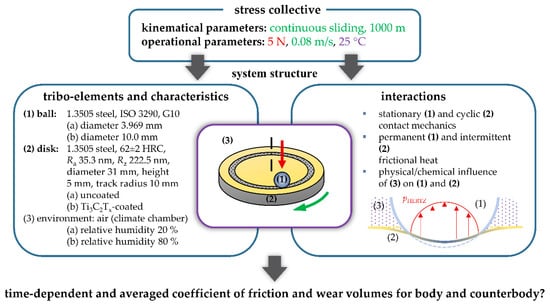
Figure 4.
Example for a tribological reference method as studied in [26].
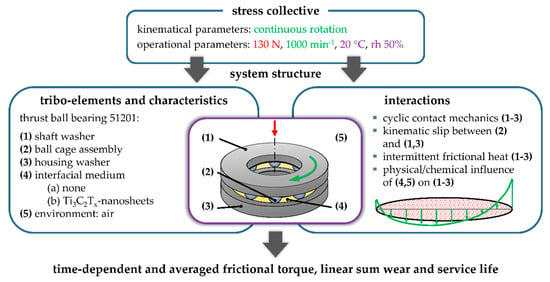
Figure 5.
Example for tribological component testing as studied in [27].
2.4. Concepts and Terminology in the Domain of Tribology
Originating from the use cases and CQs, tribAIn was modeled following a middle-out approach [25]. Thereby, the five main concepts were firstly defined as work areas before specifying and generalizing them with terms and axioms. These are “sample”, “model”, “parameter”, “procedure”, and “results”. In the following, the CamelCase notation is used for initially denoting tribAIn concepts and tAI is used as a prefix for the tribAIn IRI (Internationalized Resource Identifier). The center of tribological experiments is the sample, which defines a reference for a real-world problem and, depending on the level of abstraction [13], is investigated under more or less strongly regulated conditions. In the domain of tribology, the sample is defined through a TriboSystem, which consists of at least one Body and CounterBody, possibly an IntermediateMedium and the AmbientMedium. The tribAIn concept TriboSystem is formally defined as:
Furthermore, the sample is tested through a methodical Procedure, which has a defined StressCollective and interactions. The procedure, in this case the experiment, results in some ExperimentalResults on the tribological behavior, e.g., the coefficient of friction or the wear volumes of body and counterbody as averaged values or in dependency of time. An example of the methodical procedure for acquiring and displaying friction and wear data for defined material pairings and test conditions to investigate highly topical research questions as studied in [26] is shown in Figure 4. This included in particular ball-on-disk-tribometer tests, a common reference system [13], as well as accurate ex situ material and surface characterization. Within the test setup, the disk is defined as the body and the ball as the counterbody, which are forced to fulfill relative motion, leading to friction and wear in the contacting area.
Putting the sample in the focus of tribAIn is due to its role as a carrier for all attributes, which are important to reproduce, compare, and analyze experimental results. Material parameters and testing conditions have an influence on the resulting friction and wear behavior. Moreover, attributes resulting from the manufacturing and pretreatment of samples also have to be documented for each test setup. Within tribAIn, the concept IndustrialProcess therefore summarizes all relevant procedures, like heat treatment or polishing, which concern the sample besides experimental actions.
The design of a test series often contains more than one sample, which are tested under the same conditions and with the same attributes in order to ensure statistical certainty. The concept TestSeries can be assigned to the subconcepts of CategoryOfTribologicalTesting, which categorize investigations by their complexity and scale as shown in Figure 2. For reasoning over experimental results and the interrelated influences, it is appropriate to group the samples with the same attributes and test conditions defined by parameters and connect the aggregated results and interpretation. This further equates the general character of assessing tribological experiments. Therefore, tribAIn contains the concepts SampleGroup and ReferenceGroup, which is due to the design of test series as a comparison between at least one sample and a ReferenceSample. As indicated in Figure 6, the core of tribAIn is threefold following the process from Figure 3, with the sample in the center bridging the gap between concepts for describing the procedure (TribologicalTesting, characterization), the experimental results (FrictionalBehavior, WearBehavior), and the experimental design (TribologicalReferenceMethod). Besides the is–a relationship for signing parent-child-inheritance, the most widely used relation is part–of, which is further specified through specific terms to explicitly describe the “part” in the relation, like hasBody.
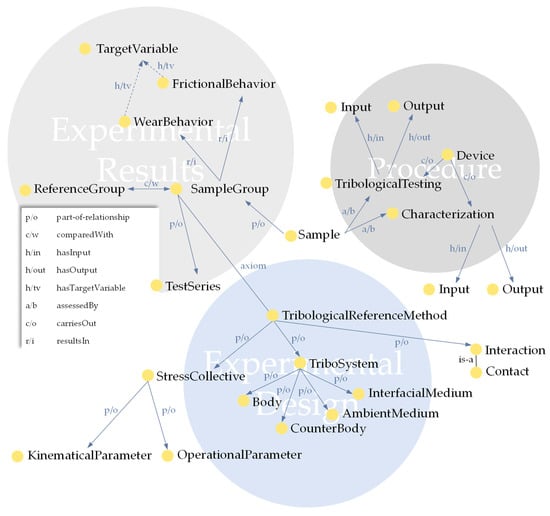
Figure 6.
Core concepts yellow circles) and relationships (blue arrows) of tribAIn.
As mentioned before, a main challenge in reusing tribological knowledge is the current documentation of the experimental design step, the interpretation of which highly assumes background knowledge of experimental methods in the domain of tribology. Therefore, tribAIn provides formal and precise definitions of the model elements in tribological experiments supporting the domain expert by the search for information for experimental design. Enabling the comparison of different tribological reference methods (Figure 6), the following general class axiom categorizes all entities in the knowledge base consisting of a contact, a stress collective, and a tribosystem under the concept TribologicalReferenceMethod:
Within the reference method, the contact of the two relatively moving objects is specified through a material pairing, depending on which material the body and the counterbody within a specific tribosystem consist of. Therefore, a property chain axiom is used for inferring the two materials within the material pairing studied in an experiment from the constituents of the tribosystem:
Due to this, different experimental setups can be categorized and retrieved by the material pairing studied in the regarding experiments.
The core concepts were further extended by parameters via the relationship hasParameter (h/pm). The concept Parameter contains all quantities, like Force or Pressure, which can be defined for procedures, model elements, and experimental results (see also the properties of tribo-elements in Figure 4). Handling parameters as separate concepts allows the provision of more provenance information. Besides the specification of the unit, this modeling decision enables the addition of measurement deviations for a specific device or a time stamp for the measurement. Moreover, handling each measurement as a single object with a value (hasValue) and additional provenance information allows the analysis and comparison of sensor data as intended in the third use case. Otherwise, dealing with units as concepts of an ontology would lead to difficulties, as semantics of the term “unit” intend the existence of only one individual per unit. For instance, the individual Newton is the single member of the concept Newton, which is a ForceUnit. Therefore, it is difficult to discern whether a unit should be modeled as a class or an individual. Within tribAIn, the punning modeling technique [26] allows use of the same name for a concept and an individual. For a link between the corresponding tribosystem and the output parameters, the tribAIn concept MeasurementSeries is intended for individual measurement series of each sample. Since more than one parameter is measured by a device, each measurement series is the output of an individual of the type TribologicalTesting (via hasOutput), which is directly connected with the sample (Figure 7). Due to this, the data from an output file of a specific sample is separated in different measurement series for each measured parameter, which is further specified at least by a value (hasValue, h/v), a unit (hasUnit, h/u), and a time stamp (TimeStamp).
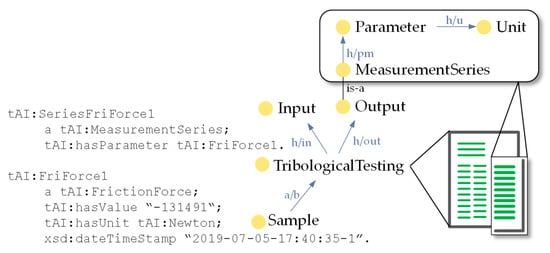
Figure 7.
Modeling measurement series as output from tribological testing.
Since measurement series are the output produced by a specific device, tribAin provides concepts for further information about the device used in tribological testing and two ways of adding information to a specific device (Figure 8). First, including individuals of the concept Component or its subconcepts and defining parameters (e.g., geometry, material) of components of the device. Second, linking existing documents (e.g., technical descriptions, standards) to the device, which contain the relevant information. This allows the integration of information about standardized testing devices by linking regarding technical descriptions or standards, as well as including documentation of customized devices or components by specifying components and/or linking content from CAD (computer-aided design) (e.g., ASM, PRT and DRW-Files).
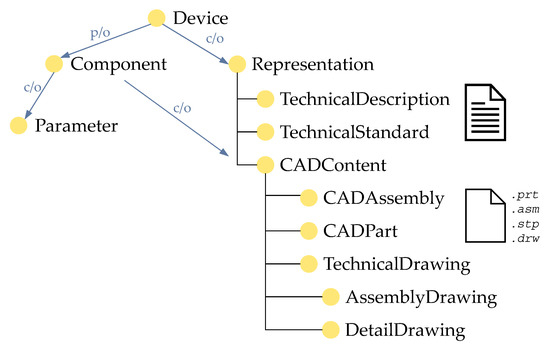
Figure 8.
Integration of information about the device used in experiments.
Originating from the core concepts in the domain of tribology, we abstracted and generalized tribAIn reusing concepts from the EXPO [22], which was formerly introduced as an intermediate-level ontology of scientific experiments. Besides concepts like ExperimentalHypothesis, which is used to relate research hypotheses and questions to an experiment, tribAIn contains a concept for describing a Role within an experiment. Two main subconcepts are SubjectOfExperiment and ObjectOfExperiment. The former is used to sign who carries out an experiment, the second one contains concepts to describe on what an experiment is carried out, in particular the Sample. Even if the tribological experiment itself is performed by test rigs, the human factor might always have an impact on the experimental results. Thus, this factor was assigned to the respective sample and the concerning procedure. The use of the EXPO concept TargetVariable additionally enables to explicitly state which parameter is the target of an investigation, as in most cases, specific parameters are varied to assess its influence. Therefore, an individual can be both at the same time, a specific parameter like NormalForce and also a TargetVariable. Experimental results (e.g., frictional or wear behavior) are generated by the interpretation of the (statistically) analyzed and compared measurement series of a sample group with the regarding reference group. A specific sample group is signed by the target variable. Another property chain axiom is used for inferring the target variable of an experimental result from the regarding sample group:
Due to this, experimental results can be grouped and retrieved by the target variable of an investigation.
With the reuse of concepts from the EXPO, tribAIn also contains the concepts from SUMO [23], which are specified by the related EXPO terms. The formal representation of tribAIn is in the Web Ontology Language OWL 2 DL [30] and was carried out in the ontology editor Protégé [31]. The current version of tribAIn is accessible under https://github.com/snow0815/tribAIn.git.
3. Results
3.1. Use Case: Competency Questions with Regard to MXene Nanosheets as Solid Lubricants
For the use case described in Section 2.3, the following research questions are formulated as competency questions for testing the coverage of tribAIn in this particular use case:
- What is the influence of the ambient relative humidity on the friction behavior in dry steel/steel sliding contacts?
- Are MXenes able to reduce friction and/or when used as a solid lubricant in dry steel/steel sliding contacts?
- What is the influence of pressure on the friction and wear performance of MXene-coated steel/steel contacts under dry sliding?
- What is the influence of the ambient relative humidity on the friction and wear performance of MXene-coated steel/steel contacts under dry sliding?
3.2. Linking Experimental Design and Results
As already discussed, the difficulty of providing tribological knowledge from experiments is caused by a lack of terminological standards, the practice of publishing results in the natural language, as well as the distributed and heterogeneous data sources. For the previously described use cases, the following different data sources are linked via tribAIn:
- The testing device provides output tabular data in CSV (comma-separated values) format;
- Technical description, CAD models, and technical drawings;
- The results as well as their interpretation are described in the natural language; and
- The experimental design and parameters of the experimental setup are roughly implicit and can partly be accessed by interpreting the information from the CSV files’ header and the description in the publication.
The tribological reference method used in the experimental design of the use case is shown in Figure 4 and was shortly introduced in Section 2.3. The ball-on-disk-tribometer tests were designed to compare the friction and wear behavior of MXene-coated samples with uncoated reference samples. This test series is signed to the concept ModelTest according to category VI from Figure 2. An excerpt from the formal description of one type of this reference method and the used parameters are shown in Figure 9.
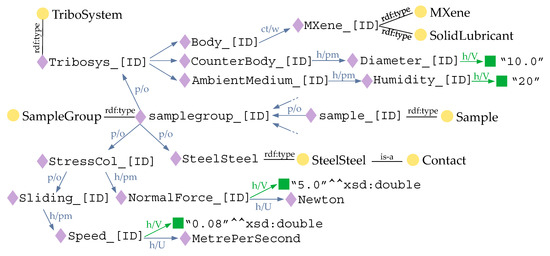
Figure 9.
Excerpt of the formal experimental design description of a sample for testing MXene nanosheets as solid lubricants.
As more than one sample was tested under the same conditions, the tribosystem, the stress collective, and the contact conditions are defined for two sample groups with coated bodies and two uncoated reference sample groups. The instantiated sample group for an ambient medium with a humidity of 20% and a diameter of 10 mm for the counterbody is depicted in Figure 9. This equates to one type of the reference method from Figure 4. The tribological model and its parameters were instantiated using the information described in the corresponding publication and the header of the CSV-output-files from the samples of this group. Besides testing parameters, the major aspect of this sample group is the body, which is coatedWith (ct/w) the material MXene used as a SolidLubricant. Therefore, the individual MXene_[ID] is of the type MXene and SolidLubricant (see Figure 9). Due to the distinction of what the individual MXene material in the particular tribosystem is, the experimental results can be differentiated from other applications of MXene. Here, the application of MXene nanosheets as a lubricant additive [32] or a reinforcement phase in composite materials [33] can be mentioned. Moreover, this enables coverage queries to find underrepresented applications of a specific material. Due to the variation of parameters of the tribosystem (humidity of the ambient medium, and contact pressure via counterbodies’ diameter), all sample and reference groups share the same individual of StressCollective and Contact (see StressCol_ID and SteelSteel), while eight different individuals of the type TriboSystem were instantiated, four as a coated sample and four as an uncoated reference sample to compare with. In this way, the experimental design is modeled in correspondence to the experimental hypothesis, which aims to investigate the influence of varied parameters by testing two different values for humidity and pressure. Moreover, formalizing the experimental design using tribAIn concepts further specifies the research aim described in the natural language within the publication (Figure 10, tAI: textualHypothesis) by explicitly locating the variation of the parameters humidity and pressure within the tribosystem. This enables the distinction from experiments, which aim, for instance, at testing the influence of different material pairings on the friction and wear behavior. The experimental hypothesis and results were further linked to the sample by annotating the respective publication (Figure 10). For the annotation of natural language text, tribAIn provides three annotation properties textualHypothesis, textualInterpretation, and textualDescription. The hypothesis in this example was formulated as an aim attached to the whole test series. In contrast, the experimental results are separately discussed for friction and wear behavior and the target variables respectively in the publication. Since an assertion about the influence of friction and wear behavior is a comparison between the sample and reference groups with varied tribosystems in this case, the annotated section in the publication was attached to the corresponding groups and the target variable. For instance, the results for a relative humidity of 20% showed an up to 2.3-fold reduction of friction for the MXene-coated bodies compared with the uncoated references (Figure 10, tAI:textualInterpretation), whereby the target variable formally signs which parameter was investigated for this result.

Figure 10.
Linking annotations from a publication to tribAIn concepts.
Yet, not only the influence of coated samples compared with uncoated reference samples was investigated in this test series. Thus, some annotations of the experimental results were attached to two different sample or reference groups, which were compared, for instance, with regard to the influence of pressure variation. Moreover, ontological annotations using tribAIn makes explicit that the results for the research aim of the whole series are classified into more than one category concerning different aspects of the applicability of MXene nanosheets as solid lubricant. For instance, the results for friction and wear behavior are separately annotated, while this is not explicitly stated in the textual research aim. Besides the interpretation of experimental results for a specific tribosystem, a consistent and transparent documentation of tribological knowledge, requires also access to the measured raw data from which the processed results are derived. Considering the output files from the present use case, the CSV format is quite inappropriate to retrace result interpretation or comparing data. Since the headers of the CSV files contain provenance information as well as data about the investigated tribosystem, the files have to be processed for categorization and comparison of the indicating parameters for the friction and wear behavior of the investigated tribosystems. As different parameters are measured within the same test setup, an individual series is generated as a triple store from the CSV files for each parameter. For instance, the COF was measured over a time period for a specific sample, thus every single value was modeled as an individual (COF_ID), containing information about the TimeStamp and the value (Figure 11).
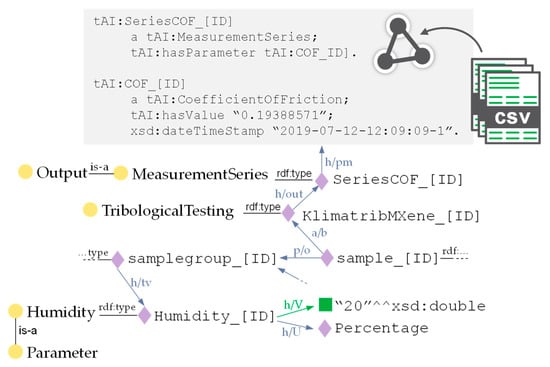
Figure 11.
Transforming output data from csv into a triplestore.
Thereby, the COF is a dimensionless quantity with no information about the unit being attached in this case. Every individual COF (COF_[ID]) is a parameter of the individual measurement series (SeriesCOF_[ID]) for each sample. Using the concepts from tribAIn to transform the CSV data into a triple store provides an explicit link between the investigated tribosystem defined for a sample group. Moreover, handling the measurement series of different parameters as single objects enables comparison of the trend of a specific parameter within different samples separately.
Since the component tests were more complex but produced output files similar to the model tests, the results can be linked equally. In this investigation, commercially available thrust ball bearings 51,201 (ISO 104) consisting of a ball cage assembly (Body), a shaft washer (CounterBody), and a housing washer (CounterBody) build the studied tribosystem (Figure 12). Since all substrates of the SampleGroup were coated with Ti3C2Tx nanosheets, the MXenes are defined as InterfacialMedium. For the thrust ball bearings, a datasheet is available containing dimensional information and is linked using an individual of the concept TechnicalDescription. All information from the data sheet can also be included by defining parameters for the different components.
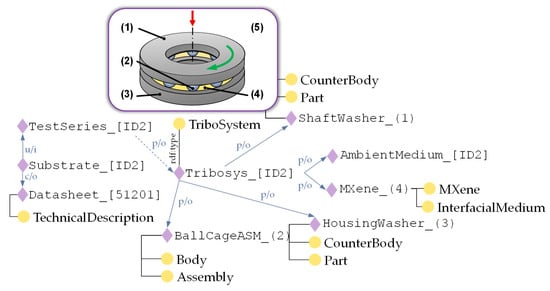
Figure 12.
Formal definition of the tribosystem studied in the component test.
Within this investigation, tribological testing was carried out by a tribometer (WAZAU, TRM 1000) with a customized mounting. For this device, CAD data and technical drawings are available, which are linked via annotation like what is shown for the drawings in Figure 13. Due to this, the technical documentation of the used devices can be queried and accessed related to a specific tribological reference method.
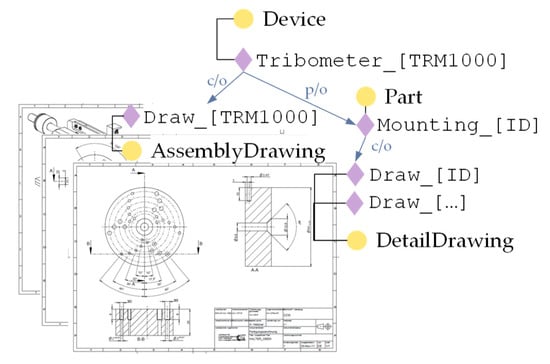
Figure 13.
Linking CAD data to a device.
3.3. Querying TribAIn
Originating from the research questions introduced in Section 3.1, formal queries were applied in the knowledge base using SPARQL 1.1 query language [34,35], showing how the knowledge linked with tribAIn can be represented. Since the research questions (1), (3), and (4) are quite similar and allocated with the general use case (1) from Section 2.2, the following query (Box 1) is exemplarily suggested for answering research question (1).
Box 1. SELECT query
- SELECT ?FrictionalBehavior ?Result ?Humidity ?refHumidity
- WHERE {?X a tAI:FrictionalBehavior;
- tAI:textualInterpretation ?Result;
- tAI:hasTargetVariable ?Y.
- ?FrictionalBehavior rdf:SubClassOF tAI:FrictionalBehavior.
- ?Y a tAI:Humidity;
- tAI:hasValue ?Humidity;
- tAI:comparedWith ?Z.
- ?Z a tAI:Humidity;
- tAI:hasValue ?refHumidity.
- ?A tAI:hasKinematicalParameter tAI:Sliding;
- tAI:hasContact tAI:SteelSteel.
- MINUS {?A tAI:InterfacialMedium ?B.}}
The SELECT expression queries four variables as expected output, which are further filtered through the WHERE expression. The filter searches for the variables under the condition of a tribological reference method with steel/steel contact, sliding kinematics, and a tribosystem without any interfacial medium (MINUS) as well as related frictional behavior as a result with the target variable humidity, which was compared with a reference humidity (Figure 14).
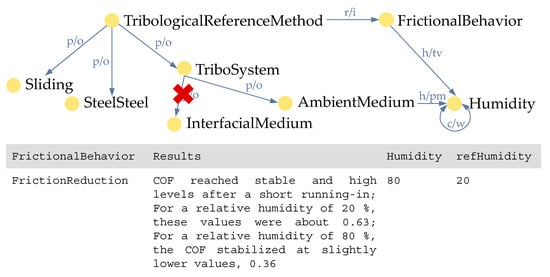
Figure 14.
Graphical example of the formulated query filter and example output for research question (1).
The output table shows the section from the publication annotated as FrictionReduction and the compared humidity values for this investigation (Figure 14). In comparison, in questions (3) and (4), the MINUS expression was replaced by another WHERE condition, which adds MXene as solid lubricant to the body of the queried reference method. Furthermore, in question (4), the target variable humidity was replaced by pressure.
Besides SELECT queries, research question (2) is suggested as the following ASK query (Box 2), which can only retrieve YES or NO stating whether a possible solution to this query exists or not:
Box 2. ASK query
- ASK {?X a tAI:TribologicalReferenceMethod;
- tAI:resultsIn tAI:FrictionReduction;
- tAI:hasBody ?Y.
- ?Y tAI:coatedWith ?Z.
- ?Z a tAI:MXene;
- a tAI:SolidLubricant.}
As the query asks for a reference method, which resulted in a friction reduction under the condition that MXene is used as a solid lubricant, the query returns YES as, for instance, the resulting frictional behavior in Figure 10 was annotated as FrictionReduction. Furthermore, the ASK query could also be used for coverage queries as intended in use case (2).
4. Discussion
As demonstrated in the use case, tribAIn allows different experimental data sources to be linked and annotated in the domain of tribology and thus enables the formalization of experimental setups and results for reuse, analsis, and comparison. Moreover, the concepts of the ontology provide an explicit specification of the three core areas of procedure, experimental results, and experimental design. The initial focus of tribAIn is on providing a formal model of the tribological reference method, which is the common basis for comparing the influences of parameters, lubricants, and coatings beyond experimental setups. As argued in the introduction, a main challenge is the accessibility of experimental results in the natural language, which leads to ambiguity in the terminology and makes them hardly comparable. This is even problematic because of the unstructured character of natural language, which is a great barrier using computer-aided processing and analyzing. A first step for the formalization is the ontological annotation within tribAIn by providing explicit concepts as exemplarily shown in the use case. Yet, it should be mentioned that the outlay of manual annotation at this initial state is rather high. Therefore, an (semi-) automatization of semantic annotation and the deployment of text mining techniques will be vital for the future application of tribAIn. This usually commences with the accessibility of non-textual documents like PDF, preprocessing of unstructured text, and goes further to section or concept extraction similar to examples in the field of structural mechanical simulations [36]. In this regard, the performance of text mining and automated annotating strongly depends on the accessibility of suitable training data. Text documents are a common publishing medium for experimental results in the field of tribology. While the shown examples of this contribution focus on the formal representation of experimental results for friction and wear behavior of a tribological system, major tasks also include surface and material characterization. Therefore, some concepts for annotating characterization results, e.g., obtained by analyzing material with microscopy producing image formats, were also included in tribAIn. The annotation of multimedia data is beyond the initial stage of tribAIn and the scope of this contribution and is the subject of ongoing research. To compensate this, the adaption of approaches like COMM [37] will be taken into account.
Another issue to deal with is the maintenance and the provision of provenance information for tribAIn. Following the AGM theory [38], there are three change operations, namely expansion, revision, and contraction. Including or removing concepts is vital for the maintenance of tribAIn, especially since the parameter and unit concepts do not have the claim to be complete for all tribological procedures. Changes in an ontology can lead to inconsistencies, which have to be resolved through appropriate methods. Nevertheless, dealing with extensions on the individual level, an OWL ontology provides more flexibility compared with relational approaches due to the open world assumption (OWA). Unlike the closed world assumption (CWA) of common databases, which follow the principle prohibiting everything until it is permitted, OWL permits every assertion until it is prohibited due to OWA. This means the lack of information within an ontology does not imply falsity, it is just unknown. In contrast, CWA assumes everything as false that cannot be proven as true. Therefore, the OWA approach represents an excellent solution for incomplete data as frequently encountered in the domain of tribology [39] due to its complexity of phenomena and testing.
Besides this, the complexity of phenomena and testing makes the comparison of experimental setups and results challenging. Within tribAIn, this was faced by integrating concepts from the underlying methodology to generalize individual testing conditions. In the use case, a model and a component test were demonstrated to evaluate the coverage of investigations from categories VI and IV. However, with increasing complexity in test setups, the coverage of tribAIn at this stage is limited. As shown in the component test, customized parts of devices can be linked by annotating technical drawings or CAD data. Dealing with more complex testing environments (categories I–III), tribAIn needs extension, for instance, to adequately describe and link complex sensor networks and their output data.
However, an ontological approach in a domain like tribology is vital regarding the computational effort for processing and analyzing data and for overcoming the challenges of ambiguity, and heterogeneous and unstructured experimental knowledge. An ontology provides interoperability between the distributed data sources and can also be expanded by mappings to existing material databases. Moreover, the formal model of an ontology enables the application of machine learning techniques for automated processing and analyzing data.
5. Conclusions
Sharing, reusing, and comparing experimental results is a major task in scientific work. Moreover, in the domain of tribology, the selection of appropriate material pairings, lubricants, and surface technologies for given requirements in scientific research as well as in practical application is strongly driven by generating experimental evidence from comparing and interpreting measurement series. Therefore, this is a highly knowledge- and experienced-based process and leads to the practice of publishing information about experimental design and the results interpretation in a natural language form to provide context to the measured data. Overcoming misinterpretation and inconsistency in terminology and in sharing tribological knowledge, classical databases reach their limits as their suitability for dealing with unstructured, insufficient, and heterogeneous data is quite limited due to their schema dependency and the absence of axiomatic representation of knowledge. Therefore, an essential step to provide a common and standardized access to the interpretation and context linked to experimental results is formalizing the so-far unstructured and heterogeneous documentation of tribological knowledge. Towards this, tribAIn represents the first step of a formal and explicit specification to enable a shared understanding in the domain of tribology.
Author Contributions
Conceptualization, P.K. and M.M.; Methodology, P.K.; Writing—original draft preparation, P.K. and M.M.; Writing—review and editing, P.K., M.M., B.S., S.T. and S.W.; Visualization, P.K. and M.M.; Supervision, B.S., S.T. and S.W. All authors have read and agreed to the published version of the manuscript.
Funding
This research received no external funding.
Acknowledgments
P. Kügler, B. Schleich and S. Wartzack gratefully acknowledge the financial support of project WA 2913/22-2 within the Priority Program 1921 by the German Research Foundation (DFG). M. Marian and S. Tremmel greatly acknowledge the continuous support of Friedrich-Alexander-Universität (FAU) Erlangen-Nürnberg, Germany.
Conflicts of Interest
The authors declare no conflict of interest.
References
- Jost, H.P. Lubrication: Tribology; Education and Research; Report on the Present Position and Industry’s Needs; HM Stationery Office: Richmond, UK, 1966. [Google Scholar]
- Holmberg, K.; Erdemir, A. Influence of tribology on global energy consumption, costs and emissions. Friction 2017, 3, 263–284. [Google Scholar] [CrossRef]
- Lee, P.M.; Carpick, R. Tribological opportunities for enhancing America’s energy efficiency. In A report to the Advanced Research Projects Agency-Energy (ARPA-E) at the US Department of Energy; Advanced Research Projects agency – Energy: Washington, DC, USA, 2017. [Google Scholar]
- Holmberg, K.; Kivikytö-Reponen, P.; Härkisaari, P.; Valtonen, K.; Erdemir, A. Global energy consumption due to friction and wear in the mining industry. Tribol. Int. 2017, 115, 116–139. [Google Scholar] [CrossRef]
- Nosonovsky, M.; Bhushan, B. Green Tribology: Biomimetics, Energy Conservation and Sustainability; Springer: Berlin/Heidelberg, Germany, 2012. [Google Scholar]
- Holmberg, K.; Andersson, P.; Erdemir, A. Global energy consumption due to friction in passenger cars. Tribol. Int. 2012, 47, 221–234. [Google Scholar] [CrossRef]
- Holmberg, K.; Siilasto, R.; Laitinen, T.; Andersson, P.; Jäsberg, A. Global energy consumption due to friction in paper machines. Tribol. Int. 2013, 62, 58–77. [Google Scholar] [CrossRef]
- Holmberg, K.; Andersson, P.; Nylund, N.-O.; Mäkelä, K.; Erdemir, A. Global energy consumption due to friction in trucks and buses. Tribol. Int. 2014, 94–114. [Google Scholar] [CrossRef]
- Fries, J.R.; Kennedy, F.E. Bibliographic Databases in Tribology. J. Tribol. 1985, 3, 285–294. [Google Scholar] [CrossRef]
- Roucoules, L.; Yahia, E.; Es Soufi, W.; Tichkiewitch, S. Engineering design memory for design rationale and change management toward innovation. CIRP Ann. 2016, 1, 193–196. [Google Scholar] [CrossRef][Green Version]
- Vakis, A.I.; Yastrebov, V.A.; Scheibert, J.; Nicola, L.; Dini, D.; Minfray, C.; Almqvist, A.; Paggi, M.; Lee, S.; Limbert, G.; et al. Modeling and simulation in tribology across scales: An overview. Tribol. Int. 2018, 125, 169–199. [Google Scholar] [CrossRef]
- Ji, Y.; Bao, J.; Yin, Y.; Ma, C. Applications of Artificial Intelligence in Tribology. Recent Pat. Mech. Eng. 2016, 3, 193–205. [Google Scholar] [CrossRef]
- Czichos, H.; Habig, K.-H. Tribologie-Handbuch; Springer Fachmedien Wiesbaden: Wiesbaden, Germany, 2015. [Google Scholar] [CrossRef]
- Cheutet, V.; Leclaire, P.; Botelho, T.D.S.; Inglebert, G. Capitalizing Data, Information and Knowledge on Mechanical Experiments through Ontologies. In IFIP International Conference on Product Lifecycle Management; Springer: Berlin/Heidelberg, Germany, 2013. [Google Scholar]
- Martinez-Cruz, C.; Blanco, I.J.; Vila, M.A. Ontologies versus relational databases: Are they so different? A comparison. Artif. Intell. Rev. 2012, 4, 271–290. [Google Scholar] [CrossRef]
- Xie, H.C.; Wang, J.D.; Kong, X.M. Web-based tribology design repository system. Sci. China Ser. Math. Phys. Astron. 2001, 44, 483–488. [Google Scholar]
- Koschmann, T.; Evens, M.W. Bridging the gap between object-oriented and logic programming. IEEE Softw. 1988, 4, 36–42. [Google Scholar] [CrossRef][Green Version]
- Xi, W.K.; Yuan, X.Y.; Jia, Q. Fundamentaal Tribology Knowledge Serve Modeling and Knowledge Resource Units Construction. In Fundamental Tribology Knowledge Serve Modeling and Knowledge Resource Units Construction; Trans Tech Publications Ltd.: Stafa-Zurich, Switzerland, 2012. [Google Scholar] [CrossRef]
- Gruber, T.R. A translation approach to portable ontology specifications. Knowl. Acquis. 1993, 2, 199–220. [Google Scholar] [CrossRef]
- Harris, M.A.; Clark, J.; Ireland, A.; Lomax, J.; Ashburner, M.; Foulger, R.; Eilbeck, K.; Lewis, S.; Marshall, B.; Mungall, C.; et al. The Gene Ontology (GO) database and informatics resource. Nucleic Acids Res. 2004, 32, 258–261. [Google Scholar] [CrossRef]
- Malone, J.; Holloway, E.; Adamusiak, T.; Kapushesky, M.; Zheng, J.; Kolesnikov, N.; Zhukova, A.; Brazma, A.; Parkinson, H. Modeling sample variables with an Experimental Factor Ontology. Bioinformatics 2010, 8, 1112–1118. [Google Scholar] [CrossRef] [PubMed]
- Soldatova, L.N.; King, R.D. An ontology of scientific experiments. J. R. Soc. Interface 2006, 11, 795–803. [Google Scholar] [CrossRef]
- Niles, I.; Pease, A. Towards a standard upper ontology. In Proceedings of the International Conference on Formal Ontology in Information Systems, Ogunquit, ME, USA, 17–19 October 2001; ACM: New York, NY, USA, 2001; pp. 2–9. [Google Scholar] [CrossRef]
- Ogden, C.K.; Richards, I.A. The Meaning of Meaning: A Study of the Influence of Language upon Thought and of the Science of Symbolism; Trench, Trubner & Company, Limited: London, UK, 1923. [Google Scholar]
- Uschold, M.; Gruninger, M. Ontologies: Principles, methods and applications. Knowl. Eng. Rev. 1996, 2, 93–136. [Google Scholar] [CrossRef]
- Marian, M.; Song, G.-C.; Wang, B.; Fuenzalida, V.M.; Krauß, S.; Merle, B.; Tremmel, S.; Wartzack, S.; Yu, J.; Rosenkranz, A. Effective usage of 2D MXene nanosheets as solid lubricant – Influence of contact pressure and relative humidity. Unpublished manuscript, last modified 25th May 2020. Microsoft Word File.
- Marian, M.; Tremmel, S.; Wartzack, S.; Song, G.; Wang, B.; Yu, J.; Rosenkranz, A. Mxene nanosheets as an emerging solid lubricant for machine elements—Towards increased energy efficiency and service life. Appl. Surf. Sci. 2020, 523, 146503. [Google Scholar] [CrossRef]
- Zhang, D.; Ashton, M.; Ostadhossein, A.; van Duin, A.C.T.; Hennig, R.G.; Sinnott, S.B. Computational Study of Low Interlayer Friction in Tin+1Cn (n = 1, 2, and 3) MXene. ACS Appl. Mater. Interfaces 2017, 9, 34467–34479. [Google Scholar] [CrossRef]
- Chen, Z.; He, X.; Xiao, C.; Kim, S. Effect of Humidity on Friction and Wear—A Critical Review. Lubricants 2018, 6, 74. [Google Scholar] [CrossRef]
- OWL 2 Web Ontology Language Primer. Available online: http://www.w3.org/TR/owl2-primer/ (accessed on 26 June 2020).
- Musen, M.A. The Protégé Project: A Look Back and a Look Forward. AI Matters 2015, 4, 4–12. [Google Scholar] [CrossRef]
- Zhang, X.; Xue, M.; Yang, X.; Wang, Z.; Luo, G.; Huang, Z.; Sui, X.; Li, C. Preparation and tribological properties of Ti 3 C 2 (OH) 2 nanosheets as additives in base oil. RSC Adv. 2015, 4, 2762–2767. [Google Scholar] [CrossRef]
- Zhang, H.; Wang, L.; Chen, Q.; Li, P.; Zhou, A.; Cao, X.; Hu, Q. Preparation, mechanical and anti-friction performance of MXene/polymer composites. Mater. Des. 2016, 92, 682–689. [Google Scholar] [CrossRef]
- SPARQL 1.1 query language. Available online: http://www.w3.org/TR/2013/REC-sparql11-query-20130321/(12.11.2018) (accessed on 26 June 2020).
- SPARQL 1.1 Update. Available online: http://www.w3.org/TR/2013/REC-sparql11-update-20130321/(12.11.2018) (accessed on 26 June 2020).
- Kestel, P.; Kügler, P.; Zirngibl, C.; Schleich, B.; Wartzack, S. Ontology-based approach for the provision of simulation knowledge acquired by Data and Text Mining processes. Adv. Eng. Inform. 2019, 39, 292–305. [Google Scholar] [CrossRef]
- Arndt, R.; Troncy, R.; Staab, S.; Hardman, L. COMM: A Core Ontology for Multimedia Annotation. In Handbook on Ontologies, 2nd ed.; Springer: Berlin/Heidelberg, Germany, 2009; pp. 403–422. [Google Scholar] [CrossRef]
- Alchourrón, C.E.; Gärdenfors, P.; Makinson, D. On the logic of theory change. J. Symb. Log. 1985, 2, 510–530. [Google Scholar] [CrossRef]
- Stachowiak, G.W.; Stachowiak, G.B.; Batchelor, A.W. Experimental Methods in Tribology, Transfered to Digital Printing 2007; Elsevier: Amsterdam, The Netherlands, 2007. [Google Scholar]
© 2020 by the authors. Licensee MDPI, Basel, Switzerland. This article is an open access article distributed under the terms and conditions of the Creative Commons Attribution (CC BY) license (http://creativecommons.org/licenses/by/4.0/).